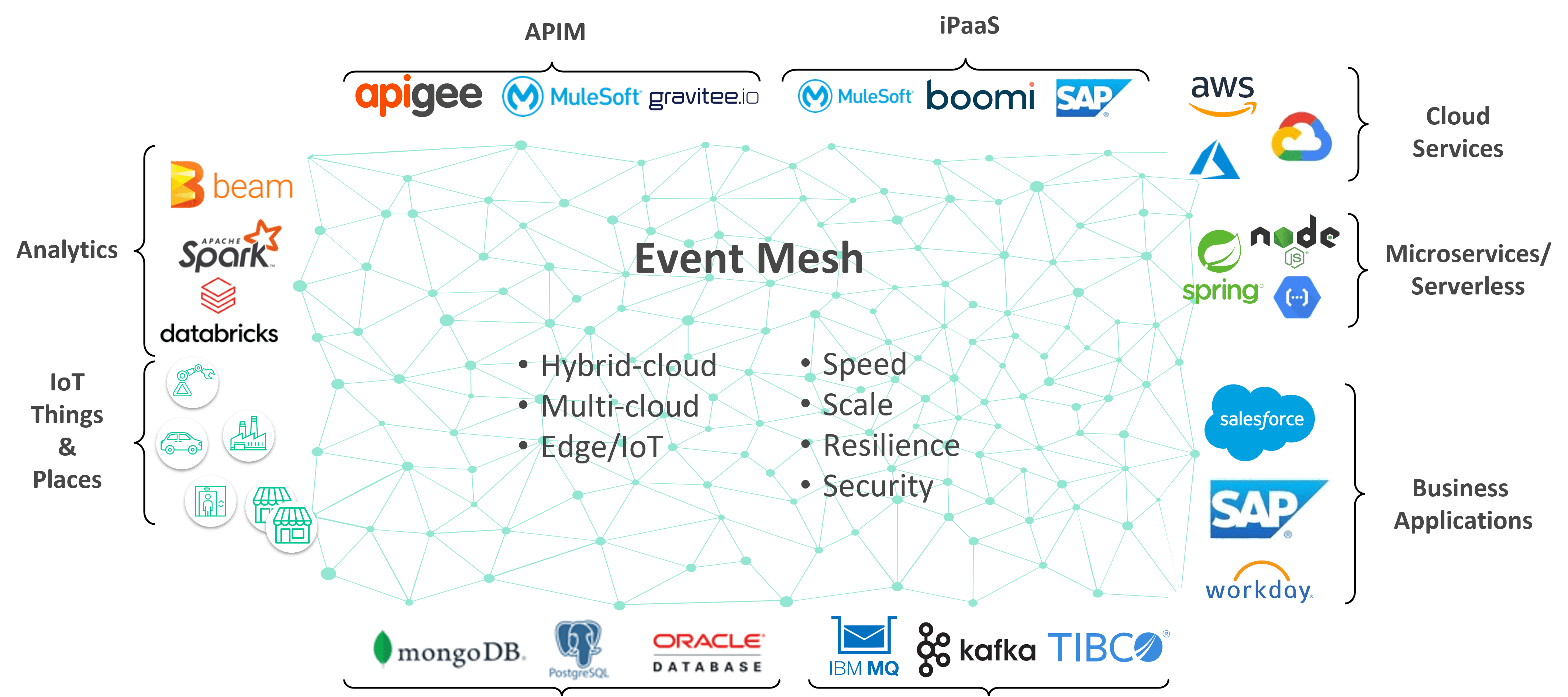Home > Blog > For Architects
The title of this piece may seem like a cliché, or an oxymoron, but this adage finds a profound and tangible expression in the concept of event mesh. With this article I’ll explain what I mean by that, and discuss what it’s like to build an event mesh with Solace technology.
An event mesh is a network of interconnected event brokers that distributes information among applications, cloud services, and devices within an enterprise in a real-time, event-driven manner. This diagram should give you a good idea of what I’m talking about.

Event mesh is an architectural pattern that enables the real-time integration of various services, applications, and systems within a distributed landscape, such as in modern cloud-native, multi-cloud and hybrid applications. Solace’s implementation of event mesh embodies the concept of enabling individual broker (the “one”) — to efficiently communicate and interact as part of a network of brokers (the “many”) to build flexible and responsive systems that can easily adapt to changing demands.
Subscribe to Our Blog
Get the latest trends, solutions, and insights into the event-driven future every week.
Thanks for subscribing.
The Power of One (Event Broker)
Solace Event Broker supports a rich set of micro-integrations that can connect legacy systems, cloud services, and IoT devices and let the enterprises fully take advantage of the capabilities of each system, while also allowing them to operate more efficiently and effectively.
Here are a few benefits of using Solace’s broker to connect your enterprise systems and processes:
- Loose Coupling: Decouples components so they can communicate through events rather than direct point-to-point exchanges. This provides the benefit of data reuse and the flexibility to change or add new capabilities without disrupting other parts of the system, fostering greater agility and scalability in your architecture.
- Scalability: Supports distributed systems by allowing multiple instances of components to connect and communicate with load balancing and event distribution. This ensures the system can handle increasing workloads efficiently, providing enhanced performance, fault tolerance, and the ability to scale seamlessly as demand rises.
- Responsiveness: Allows for quick reactions and real-time updates. This ensures timely decision-making, improved user experience, and the ability to quickly adapt to changing conditions or requirements in the system.
- Fault Tolerance and Resilience: Offers the ability to recover from failures by storing and delivering events. This ensures continuous operation, minimizes downtime, and provides the ability to recover gracefully from errors, ensuring that critical data and processes are not lost even in the event of failures.
- Flexibility: Supports introduction of new events and topics allowing the system to adapt to changing requirements easily. This enables rapid innovation, the ability to introduce new features without disrupting existing operations, and the capacity to stay aligned with changing business needs.
- Asynchronous Processing: Enables delivery of information to recipients without requiring an active connection, promoting non-blocking, parallel processing of events. This ensures improved system performance, faster throughput, and the ability to handle multiple events concurrently, reducing delays and optimizing resource utilization across the system.
- Event-driven Microservices: Can serve as a central hub for coordinating event flow, enabling the choreography of event-driven microservices. This promotes decentralized control, allowing microservices to operate independently while ensuring consistent communication and efficient orchestration, leading to greater flexibility, scalability, and responsiveness within the system.
- Guaranteed Message Delivery: Provides mechanisms for eliminating the risk of lost messages, even in the presence of failures or network issues. This guarantees data integrity, reduces the risk of service disruption, and ensures that critical information is always delivered to the right recipients, even under challenging conditions.
- Filtering and Routing: Ensures that subscribers receive only information they’ve subscribed to, minimizing bandwidth consumption and unnecessary processing. This enhances system efficiency, optimizes resource usage, and ensures that each component focuses on relevant data, leading to faster processing times and a more responsive system.
For a detailed read on the advantages of Solace Event Broker, checkout the blog on Why do Developers Need Solace Event Broker for Event-Driven Architecture?
The Power of Many (Event Mesh)
While a single broker can offer many benefits, multiple brokers allow for more robust, scalable, and geographically distributed systems, providing greater fault tolerance, enhanced performance, and flexibility for complex architectures.
As demand grows, reliance on a single point of processing can become a bottleneck and introduce risk. An event mesh with Solace event brokers can connect any/all your environments (public/private clods, on premises), at which point all applications, microservices, cloud services, SaaS, iPaaS and legacy systems connected to an event broker in the mesh will be instantly and continuously connected with one another. In effect, the power of many brokers is realized as one while having close proximity to systems and users aligned with the enterprise deployment strategy.
But configuring and managing such a network of brokers is not an easy task. The complexity breaks the chart!
Creating a network of brokers manually to accomplish an event mesh architecture involves several challenges and issues that need to be managed and overcome:
- Complex Configuration: Networking and interoperability issues are complex and error-prone due to differing broker settings, protocols, and environments. This can lead to misconfigurations and communication failures, impacting system reliability.
- Scalability: As more brokers are added to meet growing demand, maintaining consistency in load balancing and event routing becomes increasingly difficult, complicating the system’s ability to scale efficiently.
- Fault Tolerance and High Availability: Implementing and testing failover and replication strategies to ensure system availability can be challenging, especially when done manually, as it requires careful planning and validation to avoid disruptions.
- Discovery and Routing: As the system grows, dynamic discovery and intelligent event routing across a distributed set of brokers become increasingly complex, requiring advanced mechanisms to ensure events are delivered efficiently and accurately.
- Monitoring and Maintenance: As the system scales, monitoring, troubleshooting, and maintenance become more complex, requiring more resources and sophisticated tools to ensure smooth operation and quickly address issues.
- Distributed Communications: Supporting multiple environments (e.g., on-premises and cloud) introduces significant overhead, as managing networking, security, and interoperability between different brokers and environments adds layers of complexity to the system.
Overcoming these challenges often requires significant expertise in distributed systems and substantial effort in configuration, testing, and ongoing management. It is one of the key reasons why many organizations look towards solutions that offer these capabilities out of the box or through simplified management tools.
The Advantages of Building an Event Mesh with Solace
Building an event mesh with Solace Event Brokers is easy! Brokers are simply deployed wherever needed, on-prem, cloud, multi-cloud and interconnected such that they form a dynamic, self-learning event mesh.
A network of interconnected brokers in an event-driven architecture helps address key non-functional requirements for modern enterprises. Geographical and jurisdictional factors influence decisions related to data management, system resilience, information sharing, and compliance. The event mesh with its configurable policies efficiently handles event distribution across regions. Deploying brokers in different jurisdictions ensures compliance with data sovereignty, residency, and privacy regulations. Placing brokers closer to users reduces latency, improving system responsiveness. A distributed broker approach also ensures system availability, even in regions with access restrictions, and respects regulatory barriers on cross-border data flows, ensuring compliance with international regulations.
In terms of business value, implementing an event mesh allows an enterprise to:
- Enhance decision making capabilities: All data that touches the event mesh is available on demand in a secure, reliable manner. This rich, real-time data source can be used to inform important business decisions surrounding operations, supply chain, finance, marketing, etc.
- Bring IT and OT data together: IT systems typically support business processes and operations while OT systems typically support physical processes and operations. By enabling communication and integration between IT and OT systems, an event mesh can help to improve the efficiency and effectiveness of an enterprise.
- Capitalize on a superior customer experience: Applications, people, and systems having access to real-time data means businesses have the ability to create personalized experiences for customers and respond to requests in real-time.
For more details, check out the blog on What is an Event Mesh and Imagine Event Mesh video that dives into the business value proposition of an event mesh for an enterprise.
What’s next?
In my next blog post on this topic, I will dive into the technical aspects of how Solace’s dynamic message routing (DMR) and scaling options make it easy to enable enterprise-grade streaming with an event mesh.
Explore other posts from category: For Architects

Giri is a developer advocate with extensive experience in various technical domains, including integration and master data management. He started his engineering journey in the classic EAI & B2B Integration space and has been a part of the integration evolution culminating in modern EDA, microservices, Spring, and other low-code/no-code frameworks. He has a keen interest in building and promoting creative solutions and is a huge fan of open-source standards and applications. He is excited to identify and explore tools and frameworks to aid businesses in their quest for achieving efficiency and increased productivity.


Subscribe to Our Blog
Get the latest trends, solutions, and insights into the event-driven future every week.
Thanks for subscribing.
